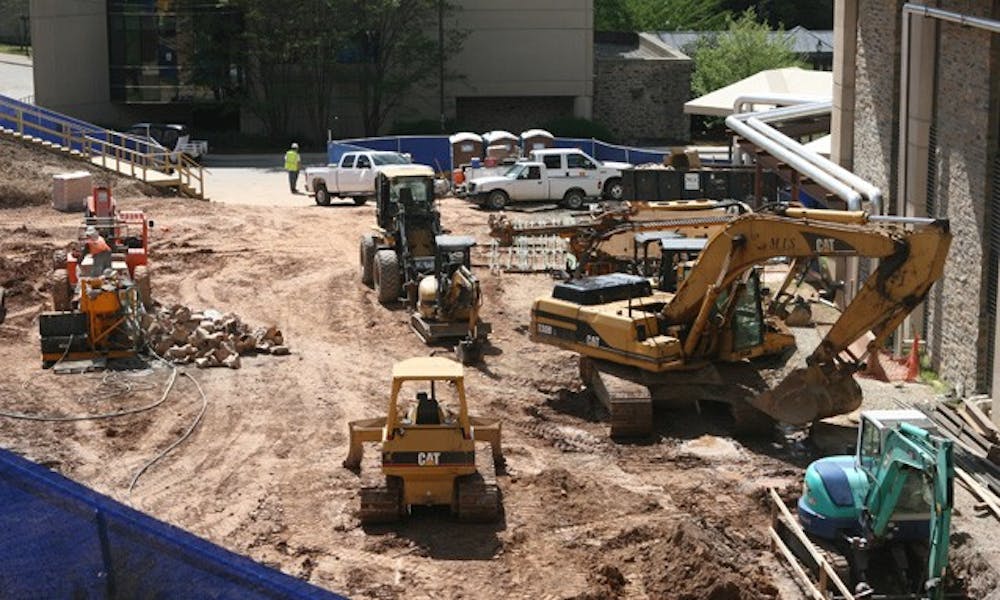Medical students, hospital visitors and patients will see the beginnings of a newly constructed medical campus upon their return to Duke this Fall.
The Duke University Health System has been working on new construction projects and expanding its campus since Fall 2009. The first project to break ground was the Duke Medical Pavilion, followed by the start of construction on the Cancer Center Spring 2010.
Most recently, construction began on the DUHS’ new Learning Center, which is expected to be completed by late 2012. According to a document from DUHS, the Cancer Center is projected to open in February 2012 and the Duke Medical Pavilion will likely open in mid-2013.
“We feel it’s very timely for these projects to be done [because of] the need for the new facilities and the updating of the facilities,” said Dr. Victor Dzau, chancellor for health affairs and president and chief executive officer for DUHS. “Our hospital and our medical school are quite old.”
These additions to the medical campus are all part of a larger vision for DUHS. The three centers are meant to become the new hub of the DUHS campus, said Dr. Monte Brown, vice president of administration for DUHS and associate dean of veterans affairs for Duke’s School of Medicine. The two sides of the medical campus—Duke North and Duke South—are also going to be connected via a closed, air-conditioned walkway connecting the two main hospitals. Construction on the walkway will begin in November.
Brown added that medical students also had a major role in the planning process of the three buildings. Students served on planning committees to help decide and provide input on facility design, layout, placement and programming.
This summer, construction of the Learning Center is in full swing, with meaningful progress ahead. The steel for the center will go up after July 4, Brown said, adding that there is now glass on three sides of the building.
The Learning Center, a facility exclusively for the School of Medicine and its students, will include a 400-person capacity auditorium, as well as classrooms and simulation suites that can transform from mock exam rooms to operating and emergency rooms, Brown said. There will also be a student life center with areas for fitness, studying and socializing—a notable improvement because it will be the first area at Duke where all medical students can congregate.
Dzau added that the Learning Center is the first medical school building of its kind to be constructed since its founding 80 years ago.
According to the document from DUHS, the Cancer Center, will contain 123 clinical exam rooms, 73 infusion stations, radiation oncology, radiology services and a mammography suite. During the next two weeks, a facilities building will be demolished to make space for open garden areas that will be used for chemotherapy infusions at the center, Brown said.
The Duke Medicine Pavilion will also provide more patient resources, containing 160 intensive and intermediate care rooms, 16 operating rooms, a patient resource center with a health library and private patient rooms with areas designated for family visits, Brown said.
“We turn away patients every day because we don’t have enough beds, so our doctors and nurses are in desperate need of this extra capacity in order to take care of the patients,” he said.
Costs for the three new facilities exceeded $880 million, as the costs for the Cancer Center, the Duke Medical Pavillion and the Learning Center are $235 million, $596 million and $55 million, respectively, Brown said. Funding for the construction came from DUHS reserves, a $300 million bond and outside fundraising. DUHS did receive a $50 million gift from the Duke endowment, $35 million of which has been applied to the Learning Center.
The financial crisis has not significantly affected the health system’s ability to build, added University Architect John Pearce.
“Duke has been very tactical in its project planning on both the University side and on the medical center side,” Pearce said. “The fact that these medical buildings have gone forward and are in construction... [means] that it’s affected that part of Duke less.”
Brown said the health system lowered its budget for construction projects by $50 million but not just because of the recession.
“Because of the financial crisis around the country, we’ve actually been able to build these buildings cheaper than previously anticipated because the economy obviously slowed down,” Brown said. “Healthcare construction [costs] before the recession [were] escalating double digits every year—it was just skyrocketing.”
After these construction projects are completed, DUHS is also considering building additional research space and improving the eye center and the Duke children’s hospital Dzau said, though he noted that those plans are still in the very early stages.
“Duke Medicine continues to perform really well and is not as much affected by the recession,” Dzau said. “Our performance is strong, and also we have planned this out very carefully, so it is not as subjective to the changes in economic climate....We’re confident we can meet these goals and all the [current] projects will be done in the next three years.”
Get The Chronicle straight to your inbox
Signup for our weekly newsletter. Cancel at any time.

